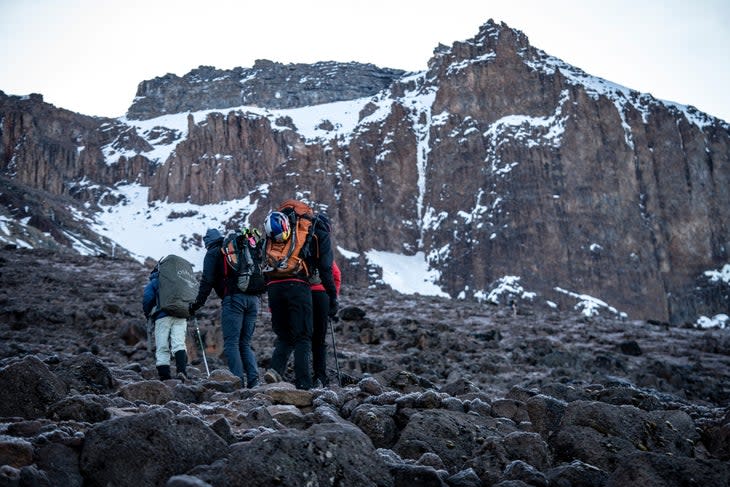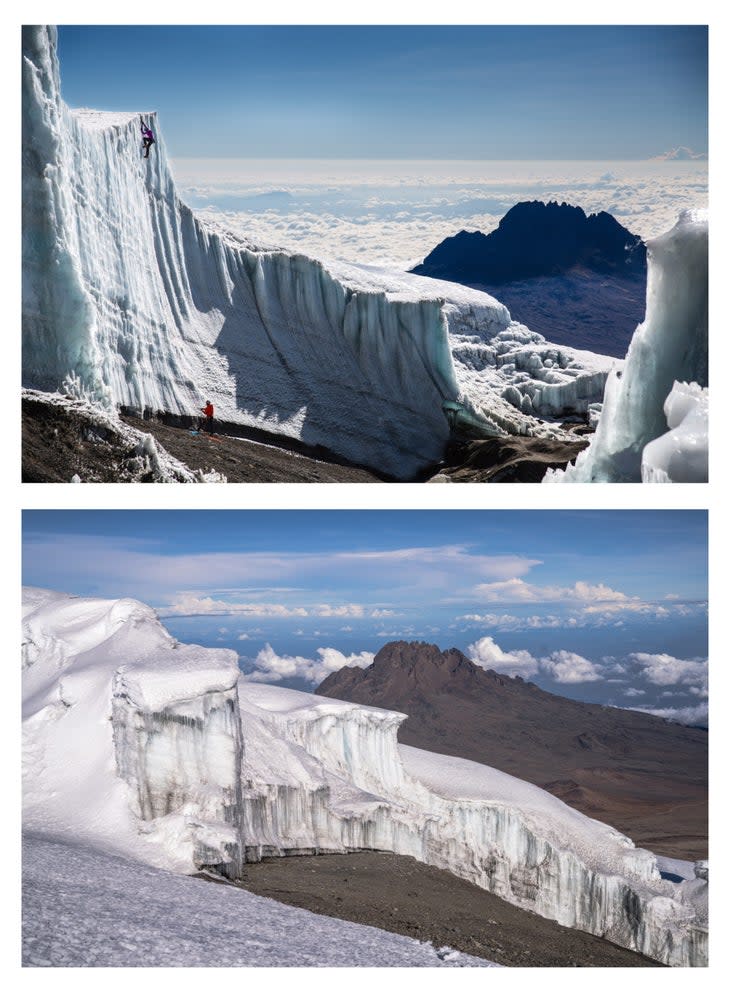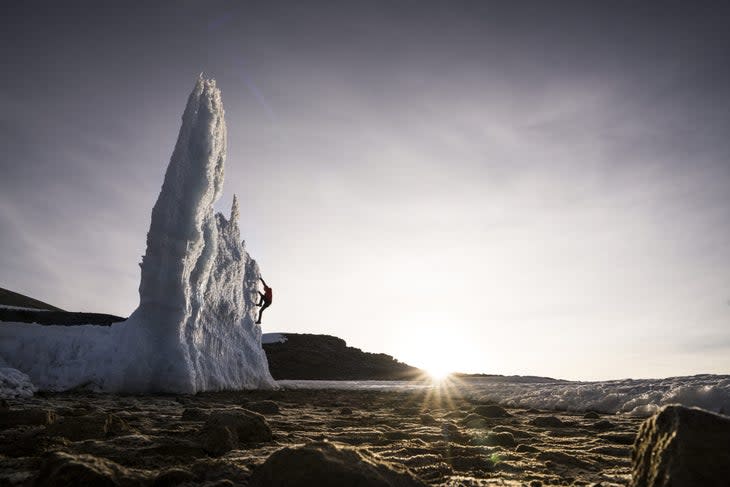Kilimanjaro, the World’s Easiest Big Mountain?
This article originally appeared on Climbing
Kilimanjaro (19,341 feet) is the highest mountain both on the African continent and in the Eastern Hemisphere. A dormant volcano, Kilimanjaro is notable as the highest free-standing mountain in the world, rising over 16,000 feet above its base on the plateau below, and also as the fourth most topographically prominent peak on Earth, after Everest, Aconcagua, and Denali.
Kilimanjaro is located in northeastern Tanzania, near the border with Kenya, and the mountain's mellow, lumbering massif extends east-west for over 50 miles. Its entirety is inside the eponymous Kilimanjaro National Park, a UNESCO World Heritage Site home to large populations of cape buffalo, elephant, giraffe, leopard, black rhino, blue monkey, and baboon. The massif is home to three volcanic cones, Kibo, Mawenzi, and Shira, with the summit, Uhuru Peak, resting on the rim of the Kibo crater--which is also the only of the three not declared "extinct." Scientists estimate Kilimanjaro last erupted over 360,000 years ago.
Uhuru Peak is accessible by seven hiking routes, none of which hold technical sections. The peak's rapidly shrinking glaciers also mean that 95% of Kilimanjaro trips don't even entail basic snow and glacier travel (axes, crampons, etc), though altitude, weather, and low temperatures still pose a threat.
Given its status as one of the Seven Summits and the relatively "easy" nature of an ascent--compared to other peaks of a similar elevation--Kilimanjaro is an extremely popular goal for trekkers and amateur mountaineers. Over 30,000 trekkers attempt the peak each year, alongside approximately 80,000 porters. It is likely the most climbed peak at its elevation, and possibly the most climbed mountain over 5,000 meters anywhere in the world.

History
Kilimanjaro features prominently in the folklore of indigenous peoples of the region, particularly the Bantu-speaking Chagga, who have lived on the slopes of the peak for thousands of years. It's unclear when or if the first ascent of Kilimanjaro was made by indigenous peoples, but given the mountain's relative technical ease, it's certainly possible.
However, a portion of this technical ease has come about only as a result of the peak's rapidly shrinking glaciers and other climate change-related impacts, which only began to occur in the 20th century. (In short, early indigenous climbers would have had to contend with significantly harsher conditions than climbers today.)
Kilimanjaro was also possibly known to non-Africans since antiquity, which is perhaps unsurprising given its extreme topographic prominence and relative proximity to the trade hub of Mombasa (165 miles) and the African coast. Second-century Egyptian mathematician and astronomer Ptolemy recorded sailor reports of a "moon mountain" in East Africa, and Spaniard Martin Fernandez de Enciso wrote of an "Ethiopian Mount Olympus" west of Mombasa in his Summa de Geografia (1519).
German missionaries Johannes Rebmann and Johann Krapf made the first recorded attempts to reach Kilimanjaro, and Rebmann's 1848 diary entries are generally regarded as the first confirmation of Kilimanjaro's existence by a non-African. Prussian officer Baron Karl Klaus von der Decken and English geologist Richard Thornton made an early attempt on the Kibo summit in 1861, though weather stymied their efforts around 8,000 feet. For much of the next three decades, several attempts were made. Notably English missionary Charles New reached the snowline around 13,000 feet in 1871.
The first recorded ascent of Kilimanjaro was on October 6, 1889, by German geographer and geologist Hans Meyer and Austrian mountaineer Ludwig Purtscheller, accompanied to high camp by local Swahili Mwini Amani and supported by two local tribal leaders and several porters.
This was the third of Meyer's attempts--an initial foray in 1887 saw him reach the edge of the Kibo ice cap, and a second attempt in 1888 was aborted after Meyer and his partner were taken hostage during the Abushiri Revolt, when local Arab and Swahili rebelled against occupying German slave and ivory traders.
Today, Kilimanjaro is a template for the impacts of climate change. The peak's glaciers have shrunk over 80% since the early 1900s, and a recent United Nations report indicated that all glaciers on the mountain--and the remaining glaciers in Africa, in the Rwenzori and Mount Kenya--will be gone by 2050 at the latest, with other reports estimating complete glacial loss on Kilimanjaro as soon as 2030.

Routes
There are seven trekking routes to summit Kilimanjaro: Lemosho, Machame, Umbwe, Mweka, Marangu, Rongai, and Shira. Unlike most mountains, route choice on Kilimanjaro is not dependent on technical difficulty, and the main difference between routes on the peak is a route's overall length, and thus acclimatization time. Other factors that typically influence route choice include cost, logistics, and scenic beauty.
Umbwe, the shortest route, is considered the most difficult, while the Machame and Marangu, significantly longer, are the most popular and least expensive. The Lemosho and Rongai, meanwhile, offer the most opportunities to see wildlife. Many outfitters also offer a combined trek, such as the "Northern Circuit," which ascends the Lemosho, circles the peak, then descends the Mweka.
Though there are no technical portions, Kilimanjaro is nearly 6,000 meters high, so altitude, wind, and sub-freezing temperatures still present serious obstacles. Most climbs of Kilimanjaro take between seven and nine days.
Despite its easy climbing nature, Kilimanjaro does hold a difficult and rarely climbed technical route, the Breach Wall Direct, first climbed by Reinhold Messner and Konrad Renzler in 1978. This water-ice V route is objectively dangerous, with rock and icefall and may be unclimbable today due to warming conditions on the mountain. The Breach Wall Icicle has seen few ascents, notablye one by Scott Fischer and Wes Krause in 1984.
Although Kilimanjaro is often regarded as an "easy" climb, statistics indicate that only 45% to 65% of attempts (by all routes) are successful. This is attributed to the fact that a large percentage of those who attempt Kilimanjaro are backpackers and hikers, not climbers, with scant (or no) experience at altitude. The mountain's reputation as an easy climb tends to attract a significantly wider demographic in terms of physical fitness, age, skill, experience, and overall health compared to other peaks of its size.
It is illegal to climb Kilimanjaro without going through a licensed agency and guiding service. As such, a Kilimanjaro trip can be quite expensive, running anywhere from $2,500 to $5,000, once flights and other additional expenses are factored in.
Facts and Figures
Elevation: 19,341 feet
Range: Eastern Rift
First ascent: October 6, 1889
First ascensionists: Hans Meyer and Ludwig Purtscheller
Annual attempts: 30,000
Average success rate: 60%
Average death rate: 0.03%
Average cost to climb: $3,000

For exclusive access to all of our fitness, gear, adventure, and travel stories, plus discounts on trips, events, and gear, sign up for Outside+ today.

